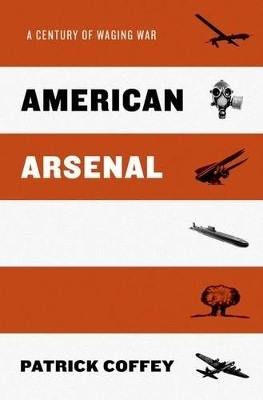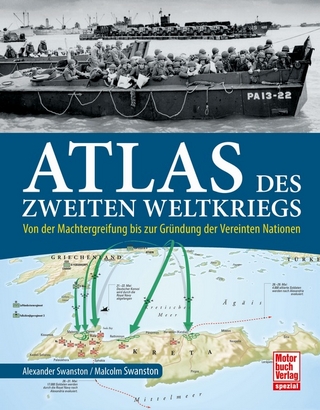
American Arsenal
A Century of Waging War
Seiten
2014
Oxford University Press Inc (Verlag)
978-0-19-995974-7 (ISBN)
Oxford University Press Inc (Verlag)
978-0-19-995974-7 (ISBN)
American Arsenal examines the United States' transformation from isolationist state to military superpower by means of sixteen vignettes, each focusing upon an inventor and his contribution to the cause.
When America declared war on Germany in 1917, the United States had only 200,000 men under arms, a twentieth of the German army's strength, and its planes were no match for the Luftwaffe. Less than a century later, the United States today has by far the world's largest military budget and provides over 40% of the world's armaments.
In American Arsenal Patrick Coffey examines America's military transformation from an isolationist state to a world superpower with a defense budget over $600 billion. Focusing on sixteen specific developments, Coffey illustrates the unplanned, often haphazard nature of this transformation, which has been driven by political, military, technological, and commercial interests. Beginning with Thomas Edison's work on submarine technology, American Arsenal moves from World War I to the present conflicts in the Middle East, covering topics from chemical weapons, strategic bombing, and the nuclear standoff with the Soviet Union, to "smart" bombs, hand-held anti-aircraft missiles, and the Predator and other drone aircrafts. Coffey traces the story of each advance in weaponry from drawing board to battlefield, and includes fascinating portraits the men who invented and deployed them-Robert Oppenheimer, head of the Manhattan Project; Curtis LeMay, who sent the Enola Gray to drop the atom bomb on Hiroshima and Nagasaki; Herman Kahn, nuclear strategist and model for Stanley Kubrick's Dr. Strangelove; Abraham Karem, inventor of the Predator and many others. Coffey also examines the increasingly detached nature of modern American warfare-the ultimate goal is to remove soldiers from the battlefield entirely-which limits casualties (211,454 in Vietnam and only 1,231 in the Gulf War) but also lessens the political and psychological costs of going to war.
Examining the backstories of every major American weapons development, American Arsenal is essential reading for anyone interested in the ongoing evolution of the U.S. defense program.
When America declared war on Germany in 1917, the United States had only 200,000 men under arms, a twentieth of the German army's strength, and its planes were no match for the Luftwaffe. Less than a century later, the United States today has by far the world's largest military budget and provides over 40% of the world's armaments.
In American Arsenal Patrick Coffey examines America's military transformation from an isolationist state to a world superpower with a defense budget over $600 billion. Focusing on sixteen specific developments, Coffey illustrates the unplanned, often haphazard nature of this transformation, which has been driven by political, military, technological, and commercial interests. Beginning with Thomas Edison's work on submarine technology, American Arsenal moves from World War I to the present conflicts in the Middle East, covering topics from chemical weapons, strategic bombing, and the nuclear standoff with the Soviet Union, to "smart" bombs, hand-held anti-aircraft missiles, and the Predator and other drone aircrafts. Coffey traces the story of each advance in weaponry from drawing board to battlefield, and includes fascinating portraits the men who invented and deployed them-Robert Oppenheimer, head of the Manhattan Project; Curtis LeMay, who sent the Enola Gray to drop the atom bomb on Hiroshima and Nagasaki; Herman Kahn, nuclear strategist and model for Stanley Kubrick's Dr. Strangelove; Abraham Karem, inventor of the Predator and many others. Coffey also examines the increasingly detached nature of modern American warfare-the ultimate goal is to remove soldiers from the battlefield entirely-which limits casualties (211,454 in Vietnam and only 1,231 in the Gulf War) but also lessens the political and psychological costs of going to war.
Examining the backstories of every major American weapons development, American Arsenal is essential reading for anyone interested in the ongoing evolution of the U.S. defense program.
Patrick Coffey is a Visiting Scholar in the Office for History of Science and Technology at the University of California, Berkeley. He is the author of Cathedrals of Science.
Introduction ; Edison at War ; Gassing the Senator ; Mitchell's War in Three Dimensions ; The Bombsight ; Precision Bombing Tested ; Napalm ; The Switch ; The Atomic Bomb ; The Weapon Not Used ; The Hydrogen Bomb ; Missiles ; Destructive Strategies ; Vietnam-the Limits of Analytical Thinking ; Star Wars ; Smart Bombs and Drones ; Epilogue
| Erscheint lt. Verlag | 10.4.2014 |
|---|---|
| Zusatzinfo | 31 b/w |
| Verlagsort | New York |
| Sprache | englisch |
| Maße | 244 x 160 mm |
| Gewicht | 567 g |
| Themenwelt | Natur / Technik ► Fahrzeuge / Flugzeuge / Schiffe ► Militärfahrzeuge / -flugzeuge / -schiffe |
| Geschichte ► Allgemeine Geschichte ► Neuzeit (bis 1918) | |
| Geschichte ► Allgemeine Geschichte ► 1918 bis 1945 | |
| Geisteswissenschaften ► Geschichte ► Regional- / Ländergeschichte | |
| Geschichte ► Teilgebiete der Geschichte ► Militärgeschichte | |
| Sozialwissenschaften ► Politik / Verwaltung | |
| Technik | |
| ISBN-10 | 0-19-995974-9 / 0199959749 |
| ISBN-13 | 978-0-19-995974-7 / 9780199959747 |
| Zustand | Neuware |
| Haben Sie eine Frage zum Produkt? |
Mehr entdecken
aus dem Bereich
aus dem Bereich
von der Machtergreifung bis zur Gründung der Vereinten Nationen
Buch | Softcover (2023)
Motorbuch Verlag
24,90 €


